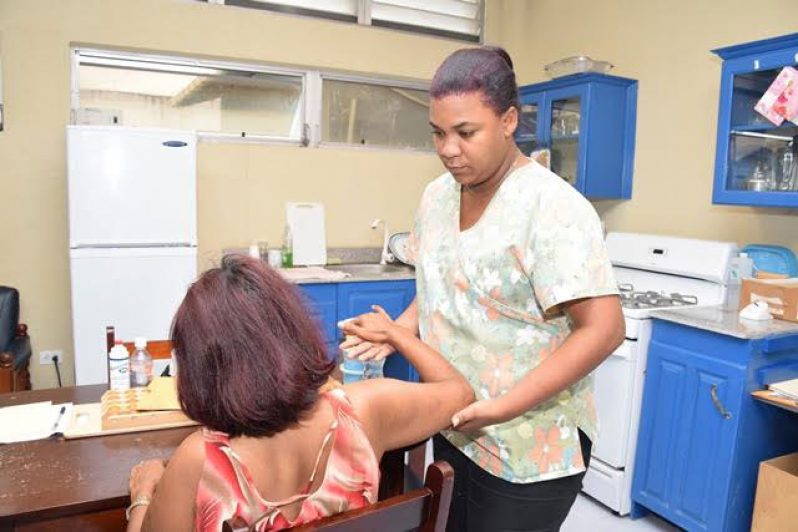PHYSICAL Medicine and Rehabilitation (PM&R), also known as physiatry, has been restoring comfort in the lives of billions of individuals worldwide. This type of treatment is a branch of medicine that aims at enhancing and restoring the functional ability and quality of life to those with physical impairments or disabilities.This treatment is designed to help patients recover from injuries, illnesses, or diseases to as normal a condition as possible. It is prescribed for many types of cases including amputations, cancer, arthritis, neurological problems, cardiac diseases, orthopaedic injuries, spinal cord injuries, stroke, and traumatic brain injuries.

There are several forms of this treatment, which include among others, physical therapy, aquatic therapy, medical nutrition therapy, sports medicine, and athletic training.
Physical therapy/rehabilitation or physiotherapy is one of the most common types of this treatment; it is also the most popular one in Guyana. These types of treatment and exercises are designed for the remediation of physical impairments and disabilities through the promotion of mobility and functional ability.
ACCESSING SERVICES
In Guyana, rehabilitation therapy is available free of cost in all of the country’s 10 Administrative Regions. It can be accessed at the country’s five main hospitals and a number of health centres, according to the Ministry of Public Health’s Rehabilitation Service Director, Mrs. Barbara Lawrence.
Care can be accessed at two centres in Region One – at Moruca and Mabaruma; in Region Two, at Suddie and Charity; in Region Three at the Leonora and Leguan hospitals; in Region Five at the Mahaicony Hospital; in Region Six at three centres; in Region Seven, at Kamarang and Bartica; Region Eight, at the Mahdia Hospital; Region Nine at Annai, Lethem and Aishalton; and in Region 10 at two centres.
Most of these facilities offer four main types of therapies: physiotherapy, which deals with mostly mobility, occupational therapy, aimed at familiarising individuals with their comfort zones, such as their work space and homes; speech therapy, which deals with the pronunciation of words and exercises for exhausted/over used tonsils along with other injuries relating to speech; and audiology, which deals with hearing disorders, and which is a major focus area, especially at the Georgetown Public Hospital Corporation (GPHC).
In addition to these facilities, individuals can also access this type of care at the Cheshire Home in Mahaica, and also at the Open Door Center/National Vocational Center for persons with disabilities, located in Sophia, Georgetown.
Under the Rehab Services Programme Seven, there are two agencies that receive subventions – the Ptolemy Reid Rehabilitation Center and the National Commission on Disability. These institutions receive approximately 5% of the National Health Budget, towards providing a better quality of life for disabled individuals, despite a few challenges.
HUMAN RESOURCES
“Our major challenge remains human resource; we do need a lot of specialised skilled professionals…but we do have a number of rehabilitation assistants…our ultimate goal is to provide quality services for persons with disability so that they can enjoy a full, productive and independent life,” Lawrence stated.
To bring some level of relief at the human resource level, training has been focused on the area of Rehabilitation Assistants. Mrs. Lawrence pointed out that, “What we have done as a country is to train mid-level workers, so we have trained Rehabilitation Assistants (a rehab assistant is someone who is trained in the three areas – physiotherapy, occupational therapy and speech therapy) to provide a basic level of rehab services.”
Since this type of treatment should be continued at home, the Ministry of Public Health also works with teachers, community volunteers and care givers. Support groups also play a major role in this form of treatment as it allows individuals with the same disability to work together and relate to each other, providing some level of extra comfort.
The Rehabilitation Unit of the country’s main referral hospital, GPHC, is doing very well. This facility sees an average of 15 patients daily in each department except for occupational therapy which sees an average of 30 patients per day.
The professional therapists provide timely, restorative medical techniques, in helping persons with temporary or permanent disabilities, to heal both physically and emotionally. This is done through modalities, which comprise hot/cold packs and electrical stimulation. This helps to strengthen, relax, and heal muscles. Individuals are given independent sessions and work time with their therapists; one session can be 30 minutes to one hour long.
The unit is housed in a separate department with audiology in a different flat; due to the fact this type of treatment requires a very quiet/isolated environment.
GPHC’s audiology facility is offering one of the most modernised types of care; this is digitalised hearing aids, which allow for a wider variety of adjustments, to suit the needs of the patients.
Monty Thompson, a patient who has benefited from this type of treatment, pointed out that it has contributed significantly to changing his life. “It (his life) has changed a lot, I could listen lil music, when my children talk to me I does hear, they don’t have to come close in my ears, that used to annoy me because I use to feel like they hollering on me, now I get the hearing aid, we could talk and watch lil picture (movies)…it more comfortable,” Thompson said.
The Ptolemy Reid Rehabilitation Centre was recently lauded by the Public Health Minister, Dr. George Norton, for doing a magnificent job. He pointed out that, “This Centre could be used as an example across the country.”
Physical therapy is believed to have been derived through the advocating of massages, manual therapy techniques and hydrotherapy by two physicians who treated people as far back as 460 BC. (GINA)




.png)









